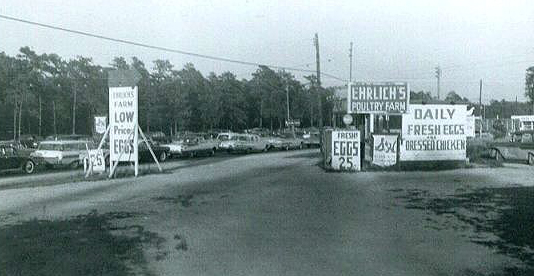|
After World War II
the former quota limits against Eastern
Europeans were relaxed, and in 1948 President
Truman signed a bill to admit some displaced
persons, including survivors of the
concentration camps. In 1950, another
bill expanded the numbers who would be
admitted to the United States.
Thus another wave of Jewish immigrants
migrated to farm lands in South Jersey.
|
Between 1946 and 1952
approximately 2500-3000 Holocaust
survivors from Eastern Europe settled on
small farms in New Jersey. These
refugees were guided by the Jewish
Agricultural Society and the Hebrew
Immigrant Aid Society. They were
relatively young, but had been deprived of
education and normal social lives as a
result of the war and their experience in
the concentration camps.
Most settled in the farming centers of
Farmingdale, Flemington,Toms River,
Lakewood and the Vineland area.
Living of these farms was a means of
overcoming anti-semitism and provided an
alternative to a difficult life of poverty
in the slums of New York or Boston.
In the New Jersey farm land, they could
maintain their Jewish identities better
than in the urban areas where there was
greater pressure to assimilate.
Additionally, the transformation to
becoming "American" was easier in an
all-Jewish environment. Although
American Jews were not warm and welcoming,
they tolerated and assisted the
immigrants. Social interaction
between these groups was limited.
|
|
About 1000 of these Holocaust
survivors came to the Vineland area, "The
Egg Basket of New Jersey". The
Vineland-Bridgeton-Millville triangle,
originally settled in 1882 with the
Alliance Colony, was under-populated with
plenty of land available. It had an
ideal situation with its poximity to both
Philadelphia and New York, perfect for
marketing of crops.
These inexperienced farm settlers
established poultry farms which needed a
relatively small amount of land and
required physical labor that was not very
strenuous. The income was regular
and immediate.
In many instances, the farm land reminded
them of home, and the work and life
weregood spiritually. There was not
an immediate problem with language as they
lived in a community of other Holocaust
survivors who shared their experiences and
language. Even religious Jews were
drawn to the farm life as feeding of
animals on the Sabbath was permitted among
the Orthodox.
|
|
The Holocaust survivors built friendships
and community. Soon there were five
new synagogues in the Vineland area.
A yeshiva was eventually started for the
area's children. Many children
attended the local public schools while
helping on the family farm during the
weekends. The children played
together, building strong bonds because of
their differences from surrounding
community. Their parents spoke with
foreign accents and most had numbers
tatooed on their arms. This
generation learned a strong work ethic and
acheived through education.
The 1950's were the most prosperous years
for the New Jersey Jewish farmer.
Employment on farms declined by
two-thirds between 1950 and 1968.
The price of eggs dropped substantially in
the late 1950s because of automation,
mechanization, and competition from the
South. Combined with the high cost
of labor and feed grain, these
circumstances caused much suffering for
the Jewish poultry farmers.
Many of the farmers moved to nearby towns
and cities. They went into
manufacturing, building, real estate and
small businesses. The second
generation went off to college, encouraged
by their parents and subsequently entered
professions in bigger cities or other
South Jersey communities. For the
Holocaust survivors, the poultry farms of
New Jersey provided an environment that
enabled them to successfully enter into
the diverse community.
|

Fresh Eggs (Ehrlich's Poultry
Farm) circa 1960
Photo courtesy of Isaac Ehrlich ©
|
|

